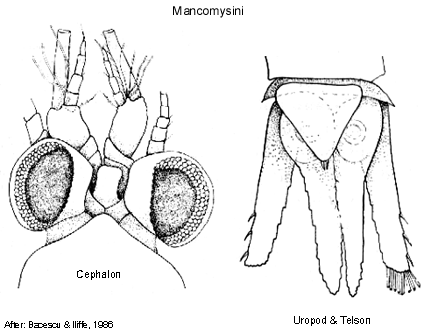 |
||||||
|
|
|
|
|
|
Mysidacea: Families, Subfamilies and TribesKenneth MelandMancomysini Bacescu & Iliffe, 1986 Diagnostic description. Head. Carapace large, last 2 or 3 thoracic somites exposed dorsally. Rostrum obtuse. Eyes normally developed. Antenna (antenna 2) scale absent. Labrum symmetric. Mandible lacinia mobilis well developed, spine row present between lacinia mobilis and molar process, molar process well developed. Thorax. 1st maxilliped exopod well developed. 2nd thoracopod developed as a maxilliped, exopod well developed. 3rd-8th thoracopods endopod with fused carpus and propodus (tarsus), carpopropodus non-segmented. Branchiae on thoracopods absent. Marsupium composed of two pairs of oostegites. Abdomen 6th & 7th abdominal somites fused. Female pleopods uniramous or greatly reduced. Uropod endopod setose around entire margin, statocyst present; exopod complete, outer margin with robust setae. Telson apex entire (triangular, three times smaller than supporting somite. Armed with a pair of small apical spines). Generic composition. Mancomysini contains 1 genus (1 species): Palaumysis simonae Bacescu & Illife, 1986. Remarks. The monotypic tribe Mancomysini is endemic for marine caves on the Palau Islands. This tribe is recognized by its's small size (2 mm), large eyes and no antennal scale.
Cite this publication as: 'Meland, K. (2002 onwards). Mysidacea: Families, Subfamilies and Tribes. Version 1: 2 October 2002. https://crustacea.net'. |
|
|
|
|
|
|
|
|
|
Copyright © Australian Museum, 2002 - 2003
Australian Museum website
